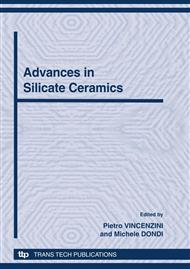p.23
p.31
p.38
p.44
p.53
p.59
p.65
p.75
p.84
Long-Term Optical and Thermal Examinations of Ceramic Wall System with Solar-Altitude Dependent Reflectance
Abstract:
Many ceramic tiles are used as outer skins of office and residential buildings and they prevent severe weathers of solar ray, temperature, wetness and wind. The solar irradiance to the outer walls is a significant factor to influence the heat flow into room and consequently the energy load due to air conditioning. Particularly in the region where clear seasonal change is experienced, optical and thermal properties of the wall surfaces are desired to be controlled as a function of season; solar reflective in hot days in summer; solar absorptive in chilly days in winter. The ceramic walls with solar-altitude dependent reflectance are expected to be a simple and efficient method for autonomous control of heat flow into the room and in this study they were investigated from the viewpoints of optical property and shape of the tiles. The correlation between solar absorption and luminous reflectance revealed that there are some ceramic tiles whose solar absorption slightly depends on solar altitude. The triangular-shaped ceramic tiles that have reflective-upward and absorptive-downward surfaces were investigated in optical and thermal properties, based on one-year exposure of the tiles to solar radiation and ray-tracing simulation. These measurement and simulation found that the triangular-shaped tiles are an effective approach to the control of solar absorption and suggested the effective shape and surface property of the tiles such as optical reflectance, surface specularity and triangular angle.
Info:
Periodical:
Pages:
53-58
Citation:
Online since:
October 2010
Price:
Сopyright:
© 2010 Trans Tech Publications Ltd. All Rights Reserved
Share:
Citation:


